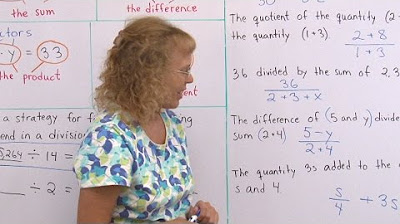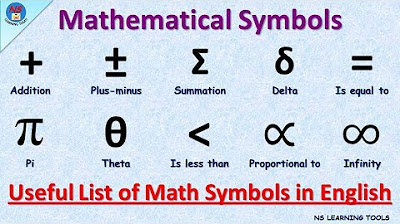MATH & GEOMETRY Vocabulary and Terminology in English
TLDRIn this educational video, Adam from engVid.com introduces essential mathematical terminology for English language learners, particularly those from non-English speaking backgrounds. He covers basic operations like addition, subtraction, multiplication, and division, explaining the corresponding terms for equations, sum, difference, product, and quotient. Adam also delves into fractions, decimals, and exponents, providing clear definitions and pronunciation guides. The video further explores geometry, discussing shapes like rectangles, squares, circles, and triangles, along with their properties and measurements. Additionally, it touches on angles, including acute, obtuse, reflex, and right angles, as well as concepts of perpendicular, diagonal, and parallel lines. Adam emphasizes that this is just an introduction and encourages viewers to explore further and seek help on the engVid forum for more complex mathematical inquiries.
Takeaways
- 😀 Adam, the presenter, is a Philosophy and English major and not comfortable with math but aims to teach math terminology.
- 📚 The video is designed to help English learners, especially those from non-English speaking countries, understand math class terminology.
- 🔢 Adam covers the basic math operations: addition, subtraction, multiplication, and division, and explains how to express equations in different ways.
- ➕ Addition is referred to as 'sum', and different phrases like '1 plus 1 equals 2' or 'the sum of 1 and 1 is 2' are used to explain it.
- ➖ Subtraction results in a 'difference', with examples like '10 minus 5 equals 5' and alternative expressions such as 'take 5 away from 10'.
- 🔄 Multiplication's result is called the 'product', and phrases like '5 times 5 equals 25' and '5 multiplied by 5' are given.
- 📈 Division's result is known as the 'quotient', and the script explains how to express division equations and handle remainders.
- 📏 The script moves on to more complex math topics like fractions, exponents, decimals, and geometry.
- 📐 Fractions are broken down into 'numerator' and 'denominator', with pronunciation tips for common fractions.
- 📊 Decimals are explained with a focus on correct terminology, such as 'zero point five' for 0.5 and the importance of the decimal point.
- 🆚 The presenter introduces comparative symbols like 'greater than' and 'less than', and their variations with equal signs.
- 🏢 The video concludes with a brief overview of shapes, areas, volumes, and angles, including specific terms like 'rectangle', 'square', 'circle', and types of triangles.
Q & A
What is the main purpose of the video by Adam from engVid?
-The main purpose of the video is to teach English terminology related to math for non-native English speakers, particularly those who might struggle with the wording in math classes in English-speaking countries.
What are the four basic functions mentioned in the video?
-The four basic functions mentioned are 'addition', 'subtraction', 'multiplication', and 'division'.
How is the result of an addition operation referred to in the video?
-The result of an addition operation is referred to as the 'sum' in the video.
What is the term used to describe the result of a subtraction operation?
-The term used to describe the result of a subtraction operation is 'difference'.
What is the term for the answer to a multiplication problem?
-The answer to a multiplication problem is called the 'product'.
What is the term for the answer to a division problem?
-The answer to a division problem is known as the 'quotient'.
How is a fraction described in the video?
-A fraction is described as a partial number, consisting of a 'numerator' and a 'denominator'.
What are the terms used to describe the parts of a fraction?
-The terms used to describe the parts of a fraction are 'numerator' for the top number and 'denominator' for the bottom number.
What is the term used for a number less than one in decimal form?
-A number less than one in decimal form is referred to as a 'decimal'.
What are the terms used for the parts of an exponent expression?
-The terms used for the parts of an exponent expression are 'base' for the number being raised to a power, and 'exponent' or 'power' for the small number indicating the number of times the base is multiplied by itself.
What is the term used for a triangle with two equal sides?
-A triangle with two equal sides is called an 'isosceles triangle'.
What are the terms for a triangle with all sides of equal length and a triangle with sides of different lengths?
-A triangle with all sides of equal length is called an 'equilateral triangle', and a triangle with sides of different lengths is called a 'scalene triangle'.
What is the term used for a triangle that has a 90-degree angle?
-A triangle that has a 90-degree angle is referred to as a 'right angle triangle'.
What is the term for the longest side of a right angle triangle opposite the right angle?
-The longest side of a right angle triangle opposite the right angle is called the 'hypotenuse'.
What are the terms used to describe angles less than 90 degrees, more than 90 degrees, and more than 180 degrees?
-Angles less than 90 degrees are called 'acute angles', more than 90 degrees are 'obtuse angles', and more than 180 degrees are 'reflex angles'.
What are 'parallel lines' and what is their defining characteristic?
-'Parallel lines' are two lines that go in the same direction and will never meet, maintaining a constant equal distance between them.
What is the term for a line that intersects another line at a 90-degree angle?
-A line that intersects another line at a 90-degree angle is called a 'perpendicular line'.
What is the term used for lines that intersect or cross each other on a graph?
-Lines that intersect or cross each other on a graph are simply referred to as 'intersecting lines'.
What are the terms for the two main axes on a graph?
-The terms for the two main axes on a graph are the 'x axis' and the 'y axis'.
What does Adam suggest if someone needs more detailed math help beyond the basics covered in the video?
-Adam suggests that for more detailed math help, individuals should look up the information on their own or ask questions on the engVid forum, but not to ask him math questions as he is not well-versed in the math part.
Outlines
📚 Introduction to Math Terminology
The video introduces basic mathematical terminology for non-native English speakers, particularly those who may be studying in English-speaking countries. The instructor, Adam, clarifies that while he is not a math expert, he will provide essential math vocabulary for understanding and communicating mathematical concepts. The focus is on the four basic operations: addition, subtraction, multiplication, and division. Adam explains how to express these operations in different ways, such as using 'plus', 'minus', 'sum', 'difference', 'product', and 'quotient'. He also emphasizes the importance of understanding the wording in math problems, especially for those who are proficient in math but struggle with English terminology.
🔢 Advanced Math Concepts: Fractions, Exponents, and Decimals
This section delves into more complex mathematical concepts such as fractions, exponents, and decimals. Adam explains the terminology associated with fractions, including 'numerator' and 'denominator', and provides guidance on pronunciation. He also discusses the representation of fractions in decimal form and the correct way to read them, such as 'zero point five' for 0.5. Exponents are introduced with the terms 'base', 'exponent', and 'power', and Adam illustrates how to express different powers, like 'squared' and 'cubed'. The concept of roots as the inverse of exponents is also briefly touched upon, setting the stage for further exploration of mathematical language.
📏 Geometry and Measurement in Math
The video script shifts focus to geometry, discussing shapes such as rectangles, squares, and circles, and their respective measurements. Adam explains the difference between two-dimensional shapes and their three-dimensional counterparts, like a box or a cube, and introduces terms like 'width', 'length', 'height', 'area', and 'volume'. He also touches on the concept of 'circumference' for circles and 'perimeter' for polygons. The explanation of geometric shapes and their measurements is aimed at helping viewers understand and communicate about spatial relationships and dimensions in math.
📐 Triangles, Angles, and Their Properties
This paragraph explores various types of triangles, including 'isosceles', 'equilateral', and 'scalene', each defined by the lengths of their sides. Adam also discusses the 'right angle triangle', which has a 90-degree angle, and introduces the term 'hypotenuse' for the side opposite the right angle. The script continues with an explanation of angles measured in degrees, including 'acute', 'obtuse', and 'reflex' angles. The importance of understanding these angles is highlighted, especially for those studying geometry. The paragraph concludes with a brief mention of perpendicular lines and diagonals, reinforcing the geometric concepts introduced.
📈 Graphs, Axes, and Parallel Lines
The final paragraph of the script addresses concepts related to graphs and coordinate systems. Adam introduces the terms 'x axis' and 'y axis', explaining their role in graphs and how they intersect at the origin. He also discusses 'parallel lines', which are lines that maintain a constant distance from each other and never meet, even extending infinitely. The script wraps up by emphasizing that while the video has covered a lot of ground, it has only scratched the surface of mathematics. Adam encourages viewers to continue their learning and to seek out more detailed information on specific math topics, while reminding them that he is available to help with vocabulary rather than complex mathematical problems.
Mindmap
Keywords
💡Addition
💡Subtraction
💡Multiplication
💡Division
💡Fractions
💡Decimals
💡Exponents
💡Average (Mean)
💡Geometry
💡Angles
Highlights
Introduction to math terminology for English language learners.
Explanation of the four basic math functions: addition, subtraction, multiplication, and division.
Describing equations in different ways without using mathematical symbols.
Use of 'sum', 'difference', 'product', and 'quotient' to describe results of math operations.
Understanding word problems in math by focusing on terminology.
Introduction to fractions, including 'numerator' and 'denominator'.
Pronunciation tips for fraction names, such as 'fifths' and 'twelfths'.
Conversion of fractions to decimals and understanding decimal places.
Explanation of 'exponents', 'base', and 'power' in mathematical expressions.
Understanding 'squared' and 'cubed' as terms for exponents of 2 and 3.
Introduction to geometric shapes, including 'rectangle', 'square', 'circle', and 'triangle'.
How to calculate area and volume of different shapes.
Differentiating between 'acute', 'obtuse', and 'reflex' angles.
Understanding 'isosceles', 'equilateral', and 'scalene' triangles.
The concept of 'hypotenuse' in right-angle triangles.
Introduction to terms like 'circumference', 'perimeter', 'radius', and 'diameter'.
Explanation of 'parallel lines', 'intersecting lines', and 'axes' in graphs.
Clarification of mathematical terms 'average', 'mean', 'median', and their uses.
Understanding comparative symbols like 'greater than', 'less than', and 'approximately equal to'.
Final thoughts on the vastness of math and the need for further self-study for detailed topics.
Transcripts
Browse More Related Video

Maths Symbols & Equations - English Vocabulary | Maths Vocabulary | Math or Maths | Basic Math

Free English Class! Topic: Math! ➗➕➖ (Lesson Only)

College Physics 1: Lecture 2 - Mathematics Review (Part 2)

Top 50 Mathematical Symbols In English and Greek

Terminology for the basic operations and writing algebraic expressions from words

List of Mathematical Symbols in English | Math Symbols Vocabulary | 65 Mathematics Symbols
5.0 / 5 (0 votes)
Thanks for rating: